Xiaomi Mi 5 vs Apple iPhone 6s
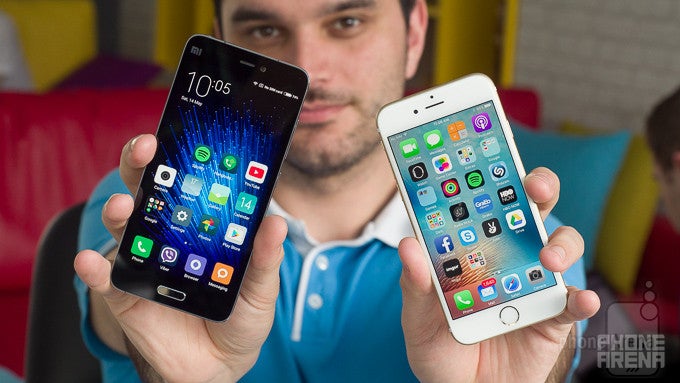
Introduction
Xiaomi is one of China’s most popular brands: the company started by making Apple clones and selling them for super affordable prices, but it has now largely moved past that stage. For a long time, it’s been hard at work to bring a new flagship and recently, it’s finally released it: the Xiaomi Mi 5.
While the Mi 5 is not officially available in the United States or Europe, it could be tempting to get a Mi 5 on eBay shipped from China. But let’s get this straight right here: unlike other major phone brands like Apple or Samsung, you have no service for the Xiaomi Mi 5 in the US or Europe. If you shatter your screen or some other problems occur, you’d need to rely on third-party repair shops, pay for those repairs from your pocket and wait longer for repairs.
This is probably the biggest downside to owning a Xiaomi phone and it’s an important consideration. Now that you’ve been warned about all this, let’s keep it out of the way and focus on the performance of the Xiaomi Mi 5 as we pit it against one of the best phones available at the moment: the Apple iPhone 6s.
Design
Both have great looks and are built to a high standard: the iPhone is more compact with a metal body, while the Mi 5 is very light and has a glass body that looks very stylish.
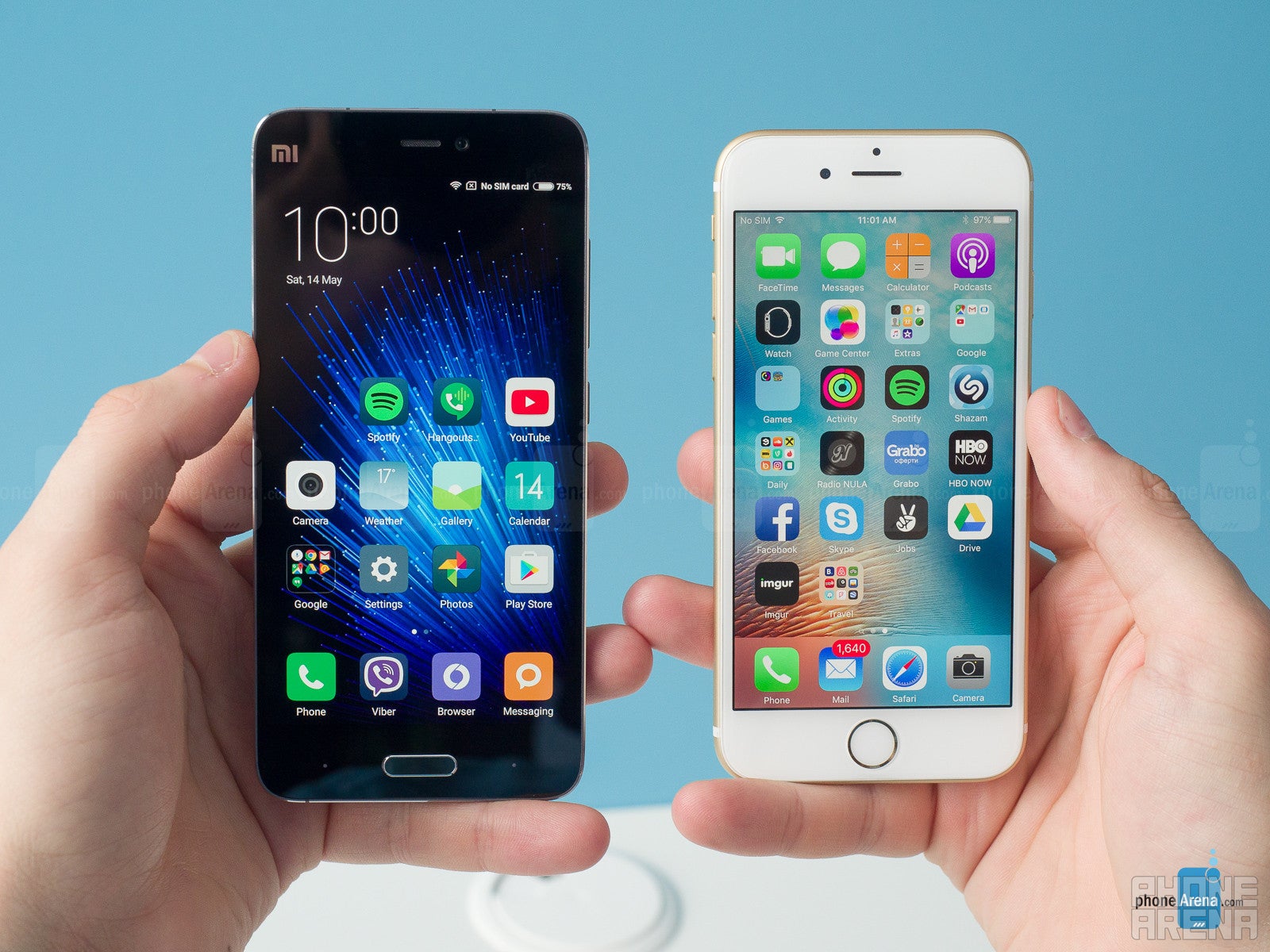
The iPhone 6s, on the other hand, is a metal affair with a small, comfortable size that fits well in the hand with those rounded edges. The iPhone 6s is, and feels, a bit heavier than the larger, but more airy Xiaomi Mi 5. Comparing the two in terms of size, the difference not too big, but you can still notice how the iPhone is the more compact. Here are the official dimensions of the two:
Mi 5: 5.69 x 2.72 x 0.29 inches (144.55 x 69.2 x 7.25 mm)
iPhone 6s: 5.44 x 2.64 x 0.28 inches (138.3 x 67.1 x 7.1 mm)
Below the display, both have a fingerprint scanner. It works impressively fast on both and while when we first saw the speed of the iPhone 6s’ scanner we thought it would go unmatched for a long time, we’re pleasantly surprised to see the Mi 5 match it in terms of speed. Both work very well and are among the finest we’ve used. The iPhone, however, clearly has the more useful finger reader: you can use it to authenticate App Store purchases and also use it to pay for goods with Apple Pay.
Display
Two great displays: the Xiaomi Mi 5’s larger 5.15” screen impresses with its bright colors, while the iPhone 6s has a 4.7” screen that is slightly better balanced.
Both the Xiaomi Mi 5 and iPhone 6s don’t have the most pixel-dense displays: the Mi 5 features a 5.15” screen with a resolution of 1080 x 1920 pixels, while the iPhone 6s has a 4.7” display with 750 x 1334 pixels.
We won’t complain about the resolution on either: both displays appear very sharp from regular viewing distance and you won’t see any jagged edges or pixelization.
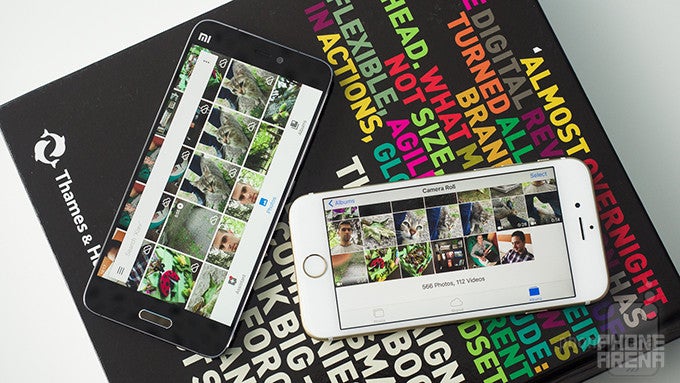
What matters more is how the two show color. Luckily, we’re dealing with two great displays in this aspect as well: the Mi 5 stands out with its very bright and vivid display, it’s really astonishing how good a display can look with such a high level of brightness that animates everything and with very deep blacks and great contrast. There are some slight color imbalances, but overall the Mi 5 has a very good looking display that conforms with the industry sRGB color standard.
The iPhone 6s, on its part, also has a very good-looking display. It’s not as bright and whites appear a bit colder on the iPhone, but it has even better contrast and color is better fine-tuned to fit the important sRGB color standard that is used for most photos and videos on the web.
Outdoors, the Mi 5 is a bit easier to see: it has a bit more reflections but its higher brightness makes it easier to read what’s on the screen outdoors.
iOS has added a nice Night Shift mode that turns colors to the red gamut at night since science says that blue colors prevent us from falling asleep easily, and that’s a nice addition, but its screen is still way too bright at night with a minimum brightness of 6 nits. The Xiaomi Mi 5 can achieve a similar to Night Shift effect with a third-party app like Twilight (free on the Play Store), but it also gets down to a much more comfortable for night reading brightness level of just 1 nit.
Interface
MIUI in its 7th version still carries trails of iOS inspiration, but the original is definitely much more polished and better suited to users in the US and Europe.
Apple’s iOS mobile platform set the tone for smartphone user interfaces. Arguable statement? Yes, but not so much when you look at phones made in China. While the Android platform has taken a quite independent road towards flat looks and its own visual style, Chinese Android phones have their own ideas of what UI should look like and usually those ideas involve copying Apple.
Xiaomi is not exactly copying Apple as much as it did before, but it’s obvious that the company is still inspired by Apple’s aesthetics: it does not use an app drawer in its MIUI 7, many apps share the same DNA with similar icons and menu style.
Unlike Apple’s closed platform, though, Xiaomi still runs the open Android at its base meaning that you have easier sharing options and wider customization capabilities with themes that change the appearance of the system almost entirely.
Xiaomi also has a few tricks up its sleeve that are unmatched on the iPhone: you can, for instance, record all your calls automatically without the need for a third-party app, it has an absolutely stunning online wallpaper collection and the option to easily swap wallpapers which is neat, it has the useful, password-protected child mode, and guest modes. The Mi 5 also has a very easy to access one-handed mode that you activate by simply swiping left or right on the home screen (you can choose to slim down the interface to a 4.5”, 4” and 3.5”).
So what about the advantages of the iOS platform? They are quite evident: it’s just better ingrained with the realities of life in a Western country: it’s got things like App Spotlight with contextual suggestions, Apple Pay, the great notification center with widgets, cool and useful Apple-made apps including Health, Stocks and so on.
Performance and Storage
The Snapdragon 820 on the Mi 5 just flies: it feels very fast. The iPhone 6s, however, has more flow with smoother moving animations all throughout.
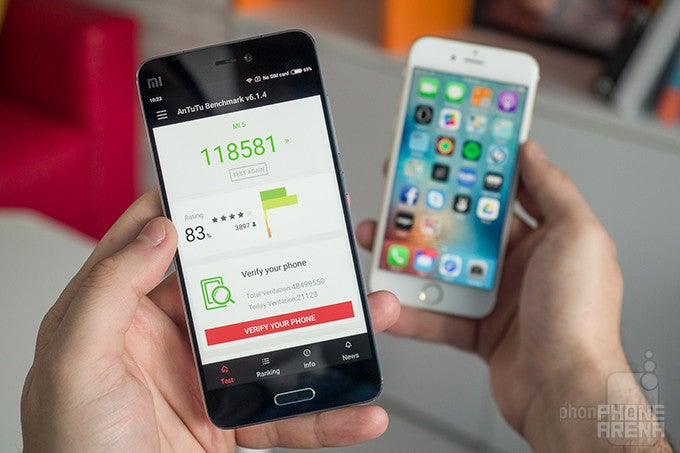
The Apple iPhone sets the tone for chip performance in the fall with its A series, while Android phones usually get their upgrades in the spring, and the Xiaomi Mi 5 is no exception. Being a spring phone, it has the latest and most powerful Snapdragon 820 system chip by Qualcomm and it just flies. Speed is the name of the game with the Mi 5: with short animations, apps open quickly and the experience feels just... fast.
Looking at the benchmarks, you’d see that the Apple A9 on the iPhone 6s is still the faster phone in terms of single-core performance, but for the first time the Snapdragon 820 chip approaches it very close.
The actual performance and speeds are handled a bit differently: on the iPhone it all feels smooth with fluid transitions all throughout, while the Xiaomi feels more abrupt, with less animations, and both are fast.
And while the Xiaomi Mi 5 features the Snapdragon 820 SoC, it comes in different versions:
- Base Mi 5 (official MSRP ~$305) has Snapdragon 820 @ 1.8GHz, 3GB of RAM, 32GB of storage
- Mid-tier Mi 5 (official MSRP ~$335) has Snapdragon 820 @ 2.15GHz, 3GB of RAM, 64GB of storage
- Upper-tier Mi 5 (official MSRP ~$400) has Snapdragon 820 @ 2.15GHz, 4GB of RAM, 128GB of storage
We have the mid-tier version here for review.
Turning over to the storage situation, the iPhone 6s starts at 16GB of non-expandable storage, then for an extra $100 you get a 64GB model, and for another $100 on top of that you can get a 128GB version.
The Xiaomi Mi 5 also does not support a microSD card slot, but its base version has double the storage of the base iPhone, which allows for greater freedom and is definitely appreciated. It’s also worth noting that despite being a relatively affordable phone, the Mi 5 does not use cheap storage: it uses the fast UFS 2.0 technology, and the iPhone does go with similarly fast storage.
Internet and Connectivity
Surfing the web on the iPhone happens mostly via Safari, Apple’s own browser that is fast and reliable, and supports a ton of useful options. The Xiaomi Mi 5, on the other hand, comes with the typical (and quite annoying) two browsers: you have the default Xiaomi browser that handles itself fine, but you also get mobile Chrome as a second option. Both options work well, with smooth scrolling and zooming actions.
Then, there is 4G LTE connectivity. And here’s where the Xiaomi fairytale ends with a bust: the Mi 5 only supports FDD-LTE bands 1/3/7, meaning it won’t be able to work properly on the 4G LTE networks in the United States and even in many parts of Europe (lots of European carriers run their networks on the support 3 and 7 bands, but also rely on band 20, which the Mi 5 does not support. If you’re in Europe check with your carrier in your area to see whether band 1, 3 and 7 will cut it for you).
The Apple iPhone 6s - in stark contrast - is one of the devices with support for multiple bands and you’re basically guaranteed to get full 4G LTE support in most markets, with faster page loads and downloads.
Camera
The iPhone is the better camera: faster and with more persistent performance, and it’s better for video as well.

Megapixels don’t tell nowhere close near the whole story on image quality, but it’s still worth knowing the technical details of a camera: the iPhone 6s has a 12-megapixel shooter with f/2.2 lens and no optical image stabilization, while the Xiaomi Mi 5 features a 16-megapixel camera with f/2.0 lens and a better-than-most, 4-axis optical image stabilization.
First, let’s look at the camera apps. The one on the iPhone is simple and straightforward: you have the large image capture key, you can adjust the exposure easily, select HDR and Live Photos, as well as control the timer. It’s fast and easy, and if you want more advanced options, you have third-party apps that give you manual controls.
The Mi 5 has an app that is not too complex, but the settings it has are very non-intuitive. At first sight, it has virtually no options, but you have to swipe from the left or right to bring some invisible menus with additional options. Getting into the settings to change basic things is also an exercise in frustration: you need to swipe from left to right to see a menu and tap on a little gear icon to get into settings. Then, you need to actually switch to the video mode to be able to tweak video settings. Confusing? Definitely.
What about image quality? Both do a very good job, but the iPhone is a step ahead: it has juicier, more pleasant to the eye colors and it is a bit faster with its shots, detail is also higher and the overall dynamics of the image are much livelier. The Xiaomi has a tendency to capture images with a comparatively toned down colors and it was not as consistent: the first image shows how it underexposed the scene severely, and in many others the greens turn out yellow-ish, while most images don’t have as dynamic and captivating a look as on the iPhone.
For selfies, both do a good job, but we’ve seen better selfie cameras: detail is definitely not as sharp as we’d like on both phones as images turn a bit smudged and of rather mediocre quality. Both have nice colors to them, but we’ve seen better selfies. The Xiaomi has this funny default setting that tracks your face and tells you how old the person taking a selfie is. It was not even close (more than 5 years of a difference), but it’s a fun thing to show your friends and have some laughs at the wrong results.
For video, both are capable of recording at the awesome 4K Ultra HD resolution as well as 1080p at either 30 fps or 60 fps (and there is a slo-mo option on both as well). The iPhone is the superior phone for video: it focuses faster, but also the video quality has sharper detail, handles better changing exposure and is much more stable despite the phone not having optical stabilization (digital stabilization here does wonders).
Audio
Wow, what a difference can there be between a speaker located on the same spot, at the bottom of the phone, on the different phones. The Xiaomi Mi 5 is neither very loud, nor too clear: it lacks depth and even in its highs, it lacks clarity and pronunciation. It’s okay, but not great by any means. Then you have the iPhone 6s with its single bottom-firing speaker that - without Apple advertizing it in any particular way - sounds way better than most smartphone speakers. With sufficient depth it manages to brings some of the low tones and delivers outstanding clarity in the mids and the lows (for a smartphone speaker, that is).
Then, there is another important issue that is not often talked about: audio output via the 3.5mm headset jack. Since most phones do a similar job in this regard, we don’t often discuss this, but in the case with the Xiaomi Mi 5 we have a disappointingly low output that means that the phone won’t be able to drive higher-end headphones and speakers at sufficient volume. Put simply, plug in an external speaker or headset and it might be too quiet. For music lovers, that could be a dealbreaker, so keep this in mind. The iPhone has no such issues.
Battery Life
Specs can be confusing and that’s the case with batteries: the smaller iPhone battery manages to provide more real-world battery life.
When it comes to battery life, people often quote numbers: milliamp-hours, watt-hours, and so on. However, battery life is more than just battery size and we’ve seen it on multiple occasions: two phones with the same battery size often deliver different actual battery life.

Yes, the ‘measly’ iPhone 6s battery outperforms the Xiaomi Mi 5 lasting a whole 8 hours and 15 minutes on our test, while the Mi 5 lasts for a good-but-not-great 7 hours and 27 minutes.
Those are important conclusions showing that great app management and optimizations go a long way.
Then, there is re-charge times: neither of the two phones supports Quick Charging. That’s a let-down in our book. It takes more than two hours for both of these phones to fully recharge from 0% to 100%.
Conclusion
We end with reminding you: the Xiaomi Mi 5 is not a phone meant to be sold in the U.S. or Europe. It’s only available via unofficial channels (you can find it on eBay in the United States and shop from resellers with European warehouse like GizChina’s shop in the EU), but dealing with warranties and repairs would be a huge pain. That’s probably the biggest downside to owning a Xiaomi phone right now. Then, there is the price: the phone is sold for a full retail price of $300 to $400 in China, while third-party resellers add a $100 premium on top of that.
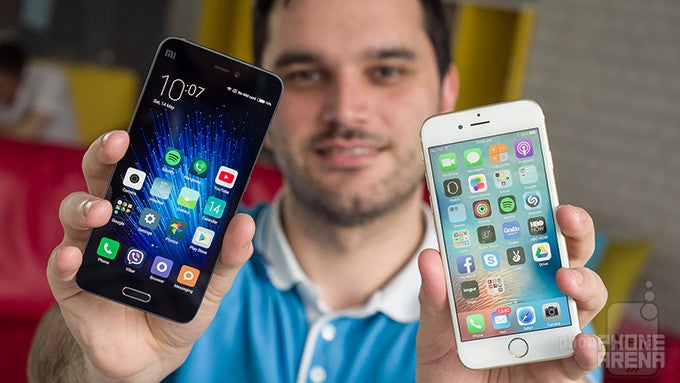
Still, at the end of the day, the Xiaomi Mi 5 is noticeably more affordable than the iPhone 6s that goes for $650 (€700) unlocked.
Despite that huge difference in price, the Mi 5 feels like a high-end phone: it has the stylish design, it has the very fast performance and extremely fast fingerprint reader, it has a decent battery life and good camera, and it has a few neat feature with its MIUI interface that are great for power users. And it has a very beautiful and bright display that impresses. It’s a great device that works well.
Nonetheless, the iPhone has the upper hand with its very reliable and smooth performance, great selection of apps and games, the better camera experience with neat new options like Live Photos and 3D Touch, and with its services that work well in the United States: things like Apple Pay and Apple Health.
If you want something different and new, though, an experiment with the Xiaomi Mi 5 will be an enjoyable adventure. Still, with no warranty and service, it remains exactly that: an experiment.
Xiaomi Mi 5
Pros
- Stylish, beautiful phone
- Bright and colorful display
- Cheaper than most other flagship phones
Apple iPhone 6s
Pros
- Unlike the Mi 5, it is sold in the US and EU, with warranty and full LTE support
- Well-built, good-looking phone
- More compact
- Takes great photos and videos
- Excellent app ecosystem

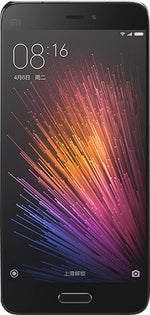

























Things that are NOT allowed: